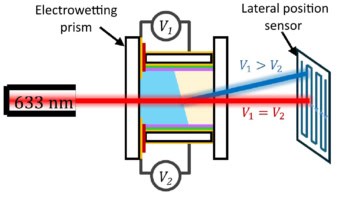
Two independent groups of physicists have built invisibility cloaks that can shield large objects lying on a plane. These “carpet cloaks” are far closer to the intuitive idea of an invisibility cloak than devices previously built, they argue, because they hide objects that can be seen with the naked eye and do so at visible wavelengths. The cloaks are also relatively cheap and easy to make, being constructed from the natural material calcite.
Carpet cloaks were proposed in 2008 by John Pendry of Imperial College, London as a way of extending the operating range of invisibility cloaks, which were mostly limited to microwave wavelengths. These devices are placed over an object sitting on a reflective plane and alter the path of light bouncing off the object in such a way that the light appears to have bounced straight off the plane.
However, all visible-light carpet cloaks built so far were demonstrated under a microscope, hiding objects no larger than 100 wavelengths across (about 50 μm). In addition, these cloaks were difficult to make, since they consisted of complex, artificially engineered materials. And they were not portable because the cloak, object and surrounding medium all tended to be made from a single structure.
Antistrophic breakthrough
The latest devices follow on from the work of Yu Luo of Zhejiang University in China and colleagues who realized last year that carpet cloaks can be built from homogeneous – rather than more complex inhomogeneous – materials, as long as those materials are anisotropic. Both devices in fact are built from the naturally occurring crystalline material calcite, the refractive index of which depends on the relative orientation of an incoming light wave’s polarization axis and the calcite’s optical axis.
George Barbastathis and co-workers at the Singapore-MIT Alliance for Research and Technology (SMART) in Singapore made their cloak by gluing together two pieces of calcite with differently oriented optical axes. These orientations were fixed such that light waves with a given polarization that bounce off a wedge-shaped object placed underneath the cloak emerge travelling in the same direction and at the same height that they would have done had they bounced straight off the mirror beneath the object. The wedge, having a base length, width and height of 38 mm, 10 mm and 2 mm respectively, can easily be seen with the naked eye.
Transformation optics
The team used a technique known as transformation optics to design their cloak. They calculated the optical parameters that were needed to transform the space between a small and a large triangle, such that light passing through this space would do so as if it were passing through all of the larger triangle, thereby effectively rendering the smaller triangle – the wedge – invisible. Having calculated these parameters the researchers were able to construct their cloak using conventional lens fabrication, with the cross section of the cloak being equal to the space between the two triangles, minus the top of the larger triangle.
The researchers then tested the cloak by directing a polarized laser beam so that the beam passed through a stencil, and then part of the emerging beam entered the cloak and bounced off the wedge while the remainder of the beam bounced directly off a reflective surface beneath the wedge. By detecting the different parts of the beam with a CCD camera they were able to show that the cloak worked. The team optimized the cloak so that it worked best at green wavelengths, which is where the eye is most sensitive, but showed that, some aberration aside, it also worked at red and blue wavelengths (arXiv:1012.2238).
Both the device and the experiment used to test it bear a striking resemblance to those of the second group, which includes John Pendry. This team published its research at arXiv:1012.2783 but is unable to discuss its work while the paper is being reviewed for acceptance in a scientific journal.
Fooling fish
Pendry’s group tested its device in air, while Barbastathis and team immersed their cloak and wedge in a tank of colourless laser oil. They did this in order to simulate the environment in which the device would be used – in the sea around Singapore. Light tends to have a particular polarization in water and so the device can be tuned to that polarization. According to SMART’s Baile Zhang, the cloak could be used by engineers to hide cables along the seabed or to help biologists image the behaviour of fish and other sea creatures unobtrusively.
Tomas Tyc of Masaryk University in the Czech Republic, who was not a member of either group, thinks that the papers “describe important achievements in the area of experimental cloaking.” But he maintains that a carpet cloak is quite different to a fully fledged Harry Potter-style invisibility cloak. He points out that a carpet cloak only really works when viewing an object – be it a rucksack or a sword on someone’s back, for example – side on. Otherwise the object will appear flat but still be visible.
Zhang acknowledges this. Making free-standing cloaks, he says, “is the direction we need to move in”. But doing so, he adds, will be very difficult since it will require the fabrication of materials with “extreme parameters”.



